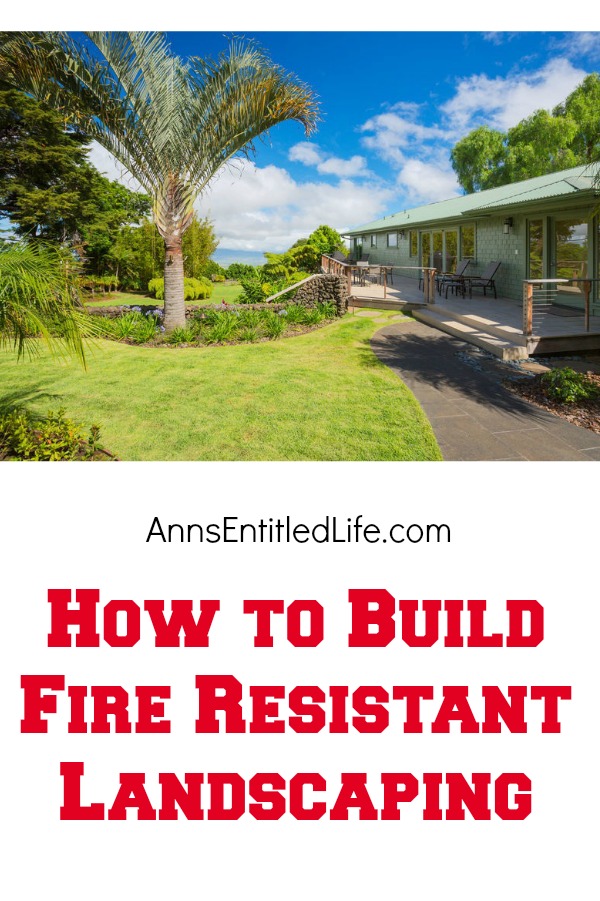Keeping your home safe from fires is obviously something that every homeowner considers, especially if you live somewhere that has frequent wildfires. Even if you live in an area that does not typically have wildfires as a norm, fire-resistant landscaping should still be a safety consideration when planting as you can never be too careful when it comes to fire. The National Fire Protection Association reminds us to “remember that brush, grass and forest fires can and do occur nearly everywhere in the United States.”
How to Build Fire Resistant Landscaping
This post will discuss the three different zones in building a fire-safe landscape as well as give you a few examples of fire-resistant plants for each zone. You do not have to sacrifice the look of your landscaping in order to make your green space more fire-resistant.
The Zones Fire Zones 1-3 refer to pockets of space around the home or structure. It’s doesn’t apply to states or geographic location other than the space in relation to the house. It refers to the defensible space. Click here for more information on fire zones.
The term Lean, Clean, and Green has been used in conjunction with fire-safe (or fire-resistant) landscaping. That term describes what you are trying to accomplish when setting up a fire-resistant landscape: well-pruned plans, trees that do not touch, well-maintained spaces, and high moisture plants and trees.
Zone 1
Zone 1 in the fire safe landscape is 30 feet in all directions around the house or building structure. The 30 feet comes from the distance a wood wall can withstand the heat of a large flame without catching fire itself.
Plants within this area should be low growing (don’t remove low growing plants as it can lead to invasive weeds) and free of oils, waxes, and resins which burn very easily and rapidly. Junipers, pines, spruces, and firs are resinous and extremely flammable.
Try not to use organic mulch, woody plants, or plants high in resin (as noted above).
Concrete, rocks, cobblestone, gravel, etc paths, patios and driveways are wonderful choices instead of plants extremely close to your house. Once you move beyond the immediate area of the house (5-10′), some great examples of plants that look great and could be perfect for this area closest to the house zone are Saltbush or Autumn Amber Sumac.
Zone 2
The fire-safe landscape in Zone 2 is approximately 30 – 100 feet from each direction of the house or building structure.
Plants in this area should again be low growing and well irrigated. In this zone be sure to mix deciduous (trees that shed their leaves) and coniferous (produce cones and are green all year) trees. Deciduous trees are generally more fire resistant than evergreens, because they have a higher moisture content when in leaf.
Create breaks that will stop or slow down a fire (fuel or fire breaks) with hardscape such as gravel, dirt, cobblestone or concrete driveways or walking paths, or green, well watered lawns.
Make certain to any prune trees in this area to keep them from reaching over 10 feet in height (6-10 feet width).
Plants that could be perfect for this zone are shrubs like Ron Williams Fine Line Buckthorn and Buckley’s Quill Mock Orange shrubs.
Zone 3
Zone 3 is 100 – 200 feet from your house or other building structure. This area should be thinned and less populated by plants than the other zones.
The best tips for zone 3 are to remove smaller conifers and remove any accumulation of woody debris. Things like fallen trees, logs, pine needles, leaves, and the like should be removed from this area if at all possible. In the reading materials (see sources below), it is suggested that you prevent tree canopies. This will help prevent a fire from spreading from tree to tree as easily as happens when the leaves and branches of the tree overlap. You want to encourage open branching.
Removing Fuel Sources
The perimeter of the house and out about 5 feet is the most dangerous. If at all possible remove any plants that are in this space. If they were to catch fire they can easily ignite the sides of the home. Also, keep any wooden mulch, leaves, or other flammable debris away from this area. As winds from the fires blow toward the house the embers will catch anything flammable near the walls on fire (such as debris, leaves, mulch, etc). Your best bet is to replace any plants next to the house with just a nice patch of good looking gravel, or hardscape walkway. If you would like to have plants very close to the house, be certain to choose ones with very low resins, oils, and waxes (this can’t be emphasized enough).
Keeping your home safe from fires doesn’t mean your landscaping has to suffer. Planting judiciously and keeping the area well maintained can go a long way toward you a beautiful, fire-resistant (fire safe) landscape.
For more information and to find great list of plants that are fire-safe and will grow well in your geographic area (state), head over to firewise.org.
Do you have any fire-safe or fire-resistant plant tips?
Sources
● Berkley.edu (There is a great annual maintenance list at that link.)
● University of California
● University of California
● Plant Select
● National Fire Protection Association
● Click here for more How Does Your Garden Grow Topics on Ann’s Entitled Life.
● Enjoy this post? Sign up for the Ann’s Entitled Life FREE Weekly Newsletter to stay connected.

Leave a Reply